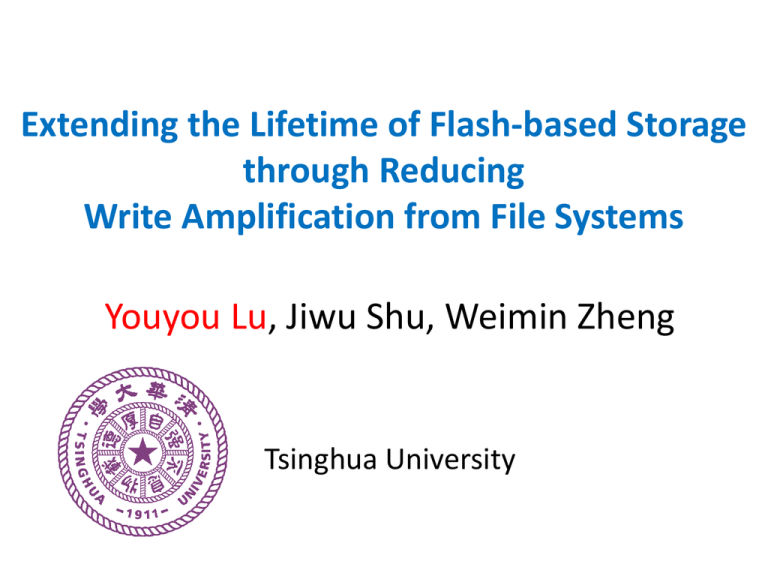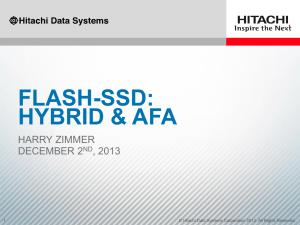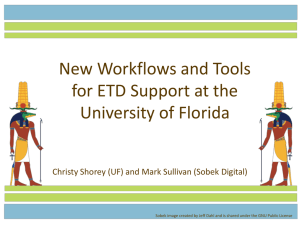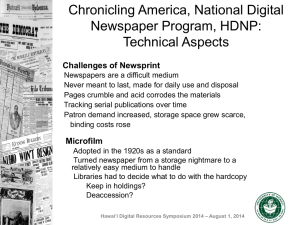Slides(PPT) - Storage Research Group
advertisement

Extending the Lifetime of Flash-based Storage through Reducing Write Amplification from File Systems Youyou Lu, Jiwu Shu, Weimin Zheng Tsinghua University Outline • • • • • Background and Motivation Object-based Flash Translation Layer System Co-design with Flash Memory Evaluation Conclusion Flash Memory • Gained Popularity – High performance, low energy, reduced cost – Wide deployment: embedded devices -> enterprise servers • Endurance – SLC (100,000) – MLC (10,000) – TLC (1,000) Figure from “The Bleak Future of NAND Flash Memory” in FAST’12 Existing Approach to Flash Endurance • Wear Leveling – To make all the blocks evenly worn out – Fundamental part of the FTL • Data Reduction – To reduce the amount of data to be written – Data De-duplication and Compression – Used either in FTL or in FS Write Amplification from File Systems • Write Amplification from File Systems – Pre-FS writes vs. Post-FS writes • Journaling – Keep the journals in the logs first, – And then, checkpoint them in-place • Metadata synchronization – Frequent persistence in case of data lost or inconsistency • Page-aligned update – Wasted space within one page A simple example in ext3 • Echo “title” > foo.txt – Effective Data: 6 bytes – Flash Writes: 11 pages * 4KB/page = 44KB • Echo “texttexttext…”(4KB) >> foo.txt – Effective Data: 4KB – Flash Writes: 9 pages * 4KB/page = 36KB bmp data bmp inode Data Area data dirent bmp data dirent C data inode bmp bmp C Journal Area inode data Flash Opportunities • No-overwrite – Can the journaling use it without writing twice in the file system? • Page metadata – Can we store the backpointer to lazily write back the index while keeping consistency? • Erase-before-Update – Can we track the free space in a coarse-grained way? Outline • • • • • Background and Motivation Object-based Flash Translation Layer System Co-design with Flash Memory Evaluation Conclusion Architecture & Data Organization • Intelligent Storage Mgmt. • Optimized FS Mechanism Application VFS Syscalls File System File System (Namespace Mgmt. + Storage Mgmt.) VFS Syscalls Application Namespace Mgmt. Object File System OBJ_READ, OBJ_WRITE, OBJ_FLUSH, OBJ_CREATE, OBJ_DELETE, OBJ_SETATTR, OBJ_GETATTR Storage Mgmt. Object-based Flash Translation Layer (OFTL) READ, WRITE FLASH_READ, FLASH_WRITE, FLASH_ERASE Flash Translation Layer (FTL) Solid State Drive Hardware Raw Flash Device Hardware OFTL Data Layout Root Page Object Index MAGIC NUMBER ADDR_BLK_INFO ADDR_ATIME_LOGS ADDR_OBJ_INDEX ADDR_UW_META Block Info Meta Block Info Segment Object Metadata File Metadata Layout Diff-Layout Object Metadata File Metadata Layout Diff-Layout Diff-Data Diff-Data Object Metadata Pages Block Info Segment Block Info Segment Coarse-grained Block Lazy Indexing State Maintenance Object Data Pages Compacted Update T1. Lazy Indexing • Index Metadata – The metadata that stores the pointers (the physical addresses of other pages). • Object Index -> Object Metadata Page -> Object Data Page – Type-specific backpointers Page Metadata (OOB) PAGE DATA TYPE BACK-POINTER (oid, offset, len) Ver Tid Tcnt ... ECC Updating Window & Checkpointing Updating Window Updating Window 1.Make sure the mappings are persistent 2.Write back the updating window metadata • Transactional write – <tid, tcnt> – Count the total number of the pages with the same tid, and compare with the stored tcnt Page Metadata (OOB) PAGE DATA TYPE BACK-POINTER (oid, offset, len) Ver Tid Tcnt ... ECC T2. Coarse-grained Block State Maintenance • Free space in flash block units – Page states can be identified using the block state • Pages in FREE blocks are all free • Pages in USED blocks are all used • Pages in UPDATING blocks need to be further identified • Relaxed Metadata Persistence UPDATING w ) do n in atio c g W lo in (Al t da ing Up nd te Ex FREE Erase U Ex p d te at nd in in g W g (E ind vic ow tio n) USED T3. Compacted Update • Compact multiple partial page updates into one flash page • Co-locate the diff-page with the metadata page Diff-Layout Diff-Extent (3712, 384, 0) o_off Diff-Extent (4096, 768, 384) len addr Diff-Extent Diff-Extent (8192, 896, 1152) (16384, 196, 2048) Diff-Page 0 511 Diff-Data (0) Diff-Data (1) Diff-Data (2) Diff-Data (2) Diff-Data (3) An Example in OFSS [Inode], [diff-data: “title”] [data: “title texttexttext…”] [dirent: “foo.txt”] [Inode], [diff-data: “xttext”] OMP, <oid2, 0, 0>, ver1, Tx1, 0, [ECC] ODP, <oid2, 0, 4096>, ver3, Tx2, 0, [ECC] ODP, <oid1, 0, 4096>, ver2, Tx1, 2, [ECC] OMP, <oid2, 0, 0>, ver4, Tx2, 2, [ECC] Updating Window • Echo “title” > foo.txt • Echo “texttexttext…”(4KB) >> foo.txt Comparison of Ext3 and OFSS • • • • 80 KB (ext3) -> 16 KB (OFSS) Journals => Transactional Metadata in Page Metadata Inode => Reverse Index in Page Metadata Block/Inode Bitmap => Free Space Mgmt. in Flash Block Units Page Un-aligned Update => Compaction and Co-location Outline • • • • • Background and Motivation Object-based Flash Translation Layer System Co-design with Flash Memory Evaluation Conclusion Evaluation Method • Evaluation Metric – write amplification = flash_writes / app_writes • System Evaluation Framework – OFSS – File system RWC Trace Object File System OFTL RWC Trace File System Block Trace Utility Block Trace PFTL Flash R/W/E Flash R/W/E Overall Comparison (1) Write Amplification: OFSS = 15.1% * ext3 = 52.6% * ext2 = 10.6% * btrfs Overall Comparison (2) Write Amplification: OFSS = 36.0% * ext3 = 80.2% * ext2 = 51.0% * btrfs Metadata Amplification In OFSS, meta Ext3 ampl. is Ext2 dramatically OFSS reduced Ext3: Journaling Ext2: Bitmap and Inode Table Refer to the paper for more details of the async mode iPhoto iPages LASR1 LASR2 LASR3 TPCC 2.57 1.06 0.05 8.59 2.68 0.30 17.91 11.84 51.04 3.73 2.00 0.91 4.11 1.04 1.13 0.45 1.05 0.03 Flash Page Size Impact • Write amplification gets worse and worse as the flash page size increases • The sync mode is much more worse than the async Refer to the paper for more details of the async mode Outline • • • • • Background and Motivation Object-based Flash Translation Layer System Co-design with Flash Memory Evaluation Conclusion Conclusion • Metadata in file systems are frequently written back for consistency and durability, amplifying the writes to the flash memory • Flash memory offers opportunities for endurance-aware file system mechanisms – Journaling: transactional write – Metadata Synchronization: lazy indexing, coarsegrained block state maintenance – Page-aligned Update: compacted update Thanks! Questions? Youyou Lu, Jiwu Shu, Weimin Zheng (luyy09@mails.tsinghua.edu.cn) http://storage.cs.tsinghua.edu.cn/~lu Backup – ext3 layout Block Group Super Block Group Desp. Block Group Inode Bitmap Block Bitmap Block Group Inode Table Data Blocks Backup – Metadata Amplification (async) Backup – Impact of Flash Page Size (async) Backup – Overhead of Window Extending











